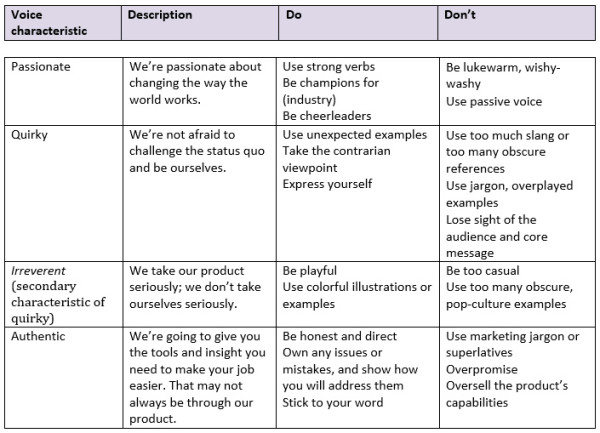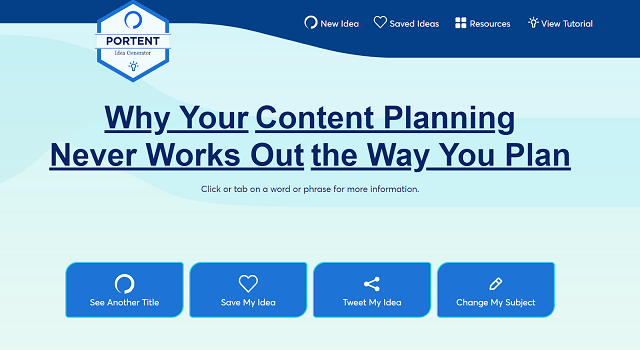As the world becomes increasingly connected and more brands pivot toward digital marketing, standing out in your niche is vital. Cutting through the noise and sparking your customers’ interests means you’ll need to capture marketing opportunities across every channel or touchpoint.
You must deliver consistent value across all of your marketing assets and implement a good content marketing plan for your:
- Website
- Social media platforms
- Mobile apps and beyond
A rock-solid content plan will help set you apart from the pack and accelerate your commercial growth. It doesn’t matter if your business is big or small.
Sounds good, right? Great, because we’re going to walk you through how to capture marketing opportunities by creating a rock-solid content plan below. But first, let’s look at what kind of marketing opportunities await in 2022 and beyond.
Three ways to capture marketing opportunities
The best way to capture marketing opportunities is by researching your target audience. Studying new consumer preferences and behaviors is a great practice for any modern brand or business. You’ll find plenty of emerging patterns that’ll help shape the direction of your content planning.
Equipping yourself with this information will also help you create a content plan that engages and inspires your audience — no matter where they interact with you.
Let’s look at ways you can capture marketing opportunities using online engagement. Use the following tactics to help grow your audience and capture their attention:
1. Immersive experiences

Explore virtual reality (VR) or augmented reality (AR) with interactive innovations like the IKEA Place app. Peek the video below to get an idea of how it works.
2. Pop-up shops and events
Set up events that merge the digital and physical world, while offering a sense of exclusivity. Workshops work great when you accompany them with educational content and how-to guides.
3. Guides and toolkits
Make sure to offer customers practical advice and guidance on your website and social media platforms. You can couple these guides with video content, knowledgeable resources, and checklists to help lead them through the customer journey.
Related: 5 useful tools to understand your clients’ needs
How to create a content plan for marketing success
Now that you know how to capture marketing opportunities using online engagement, it’s time to look at how to create a rock-solid content plan. But before we begin, let’s break down the term “content plan” for a bit of context.
A content plan is a strategy that ties together every marketing asset and idea required to achieve your core business goals.
All of the following examples can fall under the umbrella of a content plan:
- Consumer and market research
- Video creation
- Podcast development
- Blog and article writing
- Email campaigns
- Social media copy
Now that we’re all up to speed, let’s start looking at how to capture marketing opportunities by creating a content plan.
Define your golden circle
Your golden circle will form the solid foundations of your content marketing strategy. When trying to capture marketing opportunities and plan for content, it’s important to focus on defining it from the outset.
Your golden circle is a clear cut statement of:
- Why your brand or business exists: Consider how your brand’s existence improves the lives of your audience.
- What it stands for or does: Think about ways your brand offers something meaningful to your target audience.
- What it’s looking to achieve: Explore measurable ways to reach your goals with your team.
These points are the core of your brand story. They’re the reason that customers will choose you over a competitor.
To define your golden circle the right way, you must dig as deep as you can.
Review the points above with everyone else in your company before you start planning. Many businesses get this step wrong and render their content plan worthless before it’s even started to take shape.
Getting your golden circle right means you’ll need to:
- Take time developing your brand mission and story
- Seek solid answers to the questions above and ensure you’re 110% happy
- Map your thoughts out logically
Before you know it, you’ll have a brand identity that will help you shape all of your content marketing efforts across channels.
Build your buyer personas

Once you understand your mission on a deeper level, you should focus on your target audience by building personas based on your ‘ideal customers.’
Buyer personas are vital to the content planning process.
They empower you with insights about your target audience, ensuring you get the best possible results from all of your content.
Adele Revella, author of “Buyer Personas: How to Gain Insight Into Your Customer’s Expectations, Align Your Marketing Strategies, and Win More Business,” notes:
“Too often, Buyer Profiles are nothing more than an attractive way to display obvious or demographic data. Defining markets based on demographics—data such as a person’s age, income, marital status, and education—is the legacy of 60 years of selling to the mass market.”
To create buyer personas for your content plan, try
- Exploring consumer or website analytic tools like Google Analytics
- Sourcing valuable information about your target audience
- Defining attributes or behaviors you feel will offer your content plan genuine value
Now, let’s discuss two custom reports marketers use the most using Google Analytics.
User demographics and interests
A customized User Demographics & Interest report will collect data over a predetermined time frame and provide a wide range of detailed insights. Here you can uncover the following information about your users:
- Age
- Gender
- General tastes and preferences
- Interests and hobbies
These metrics will feed directly into your buyer persona information and help bring your content plan to life.
Source and medium
A Source & Medium report will help you understand the origin of your traffic over a certain time frame. It’ll also show you the medium type people use most to engage with your business. This includes things like:
- Organic search (organic)
- Cost-per-click paid search (CPC)
- Web referral (referral)
These essential metrics will help you decide which attributes are most vital to focus on when developing your content planning buyer personas. They also help you decide which channels and touchpoints you should prioritize when creating your content.
Related: Build and use your ideal customer profile and personas
Decide on your unique brand tone (find your voice)
Before you start physically planning your content, you should decide on a brand tone that is unique to your business.
A distinct brand tone will help you stand out, while also ensuring your audience recognizes your content and communications right off the bat.
When deciding your brand’s tone of voice, think about the:
- Content you like the most
- Brands you respect
- Types of language used by your competitors
The following table will give you a framework for choosing a brand tone. Use it to help you capture marketing opportunities as you plan:

Study how the pros do it
One example of a brand tone that’s strikingly impactful is Uber. Their approach empowers them to capture marketing opportunities with every content-based campaign. Take a look at the language they use on their “About us” section of their website.

As you can see, Uber’s tone is conversational and snappy. It also delivers its brand intent in a way that’s unmistakable. The natural use of ‘you’ also makes the brand’s content more personable, which ultimately increases engagement and sales.
Remember, brand tone should be equal-parts convincing and personable. Channel your unique personality into the content you create for your audience.
Related: A beginner’s guide to branding your business
Plan your content
The previous steps will ensure that your content plan is water-tight and rock-solid. It’ll also help you capture marketing opportunities with every one of your campaigns and communications.
Once you’ve laid down solid foundations, you can actually start planning the content you want to create and deliver.
Even when you’ve planned your content ahead of time, nothing is 100% set in stone.
If a marketing opportunity suddenly emerges that you believe will offer excellent results, you can tweak your content plan accordingly. Here are five other essential tips you can use for successful and collaborative content planning.
Gather your team and start brainstorming
Jot down potential ideas based on annual holidays, events or seasonal campaigns.
Create a shared content calendar
Drafting and sharing a content calendar with your team will help keep your ideas and goals in order. A good content calendar includes:
- Creation
- Development
- Distribution dates
It also outlines which channels you’re going to use to promote your content. These could include:
- Social media
- Landing pages and more
Make sure to also outline who is responsible for each task on your team.
Decide on campaign ideas and concepts
Try aiming at different segments of your audience. Our guide on using personalization to increase sales will help you with your efforts.
Refine your ideas
Decide which mediums you want to use to create your content. Some examples might include:
- Producing a standard blog post
- Creating an eBook or white paper
- Putting together an infographic
- Making a video
- Launching an online course and more
Referring to our marketing opportunities section and your consumer data will help here.
Host frequent content planning meetings
Discuss your progress and redefine any ideas you feel need changing. You’ll want to ensure they meet your consumers’ needs and leverage valuable marketing opportunities.
Editor’s note: If you’re looking for eye-grabbing designs and content ideas for a variety of seasonal campaigns, GoDaddy Studio is home to thousands of customizable graphics and templates.
Smart content planning ideation tips
By now, you should be ready to create a steady flow of content and your marketing toolbox should consist of:
- Buyer personas
- Google Analytics data
- Brand tone of voice
- Content planning calendar or hub
Conjuring up compelling content ideas that engage and inspire your audience is an ongoing task. With so many channels to consider and so much content to plan, you want to avoid getting creative burnout.
To help make your content planning and creation efforts a consistent success, you can refer to the following content ideation tips below. These will help you capture marketing opportunities, while keeping those creative juices flowing.
Craft effective content titles for your audience
Have an idea for a specific campaign or annual event that you want to give shape and direction to? One of the best ways to do this is to craft a definitive content title.
Portent’s content generator tool is an effective way of crafting compelling content titles. It offers fomulatic suggestions you can use as a working template for:
- Blog articles
- Infographics
- Videos
- Podcasts and more

For example, the generator tool in the image above has returned a title based on the search ‘content planning.’ The search results will show you several suggestions that you can use for inspiration. Jot down any suggestions you like to help you develop a content idea (or ideas).
Explore different creative or informational sources
Exploring different creative or inspirational sources will help you connect with a continual flow of rock-solid content ideas. Let’s review three sources marketers refer to often.
The competition
By looking at your competitor’s content, you can get inspiration by improving or elaborating on existing ideas. Common ways to explore, include:
- Doing a little mystery shopping
- Signing up for newsletters
- Spying on social media
- Subscribing to blogs
Any of these areas should give you plenty of fuel for the creative engine.
Your customers
When drafting up content for your customers, you can refer to them for inspiration. Try gathering direct feedback from your customer service department, then hold polls or surveys on particular subjects.
You can also look at what currently resonates best with your audience through different social media channels. Use this info to create content that offers genuine value.
Industry blogs or publications
Did you know you could sign up and check in with relevant industry blogs and publications to become more authoritative on certain subjects?
Noting content ideas from key industry leaders will help mobilize your own lightbulb moments.
The more industry content you read or consume, the more inspired you’re likely to become. It’s a simple yet powerful content ideation method.
Conclusion
Kristina Halvorson, CEO and Founder of Brain Traffic, is an expert content strategist that once said:
“The reason we struggle with content marketing is because we haven’t started with ‘Why?’ Customers don’t care about your vanity metrics. Ask them, ‘How can I help?’”
Content planning can appear daunting at first, but it’s not so bad once you get into the groove of things. The best way to get started is to:
- Lay the right foundations
- Create a content calendar
- Make sure everyone on your team is on the same page
Once you have these down, you’ll have a framework that empowers you to seize almost every marketing opportunity that comes your way. Keep the needs of your customers at the heart of your content efforts and success will be yours for the taking.
If you’re looking for the right tools or platform to make your content planning efforts a reality, explore GoDaddy’s digital marketing suite for more help.